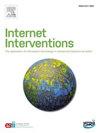Developing a qualitative and quantitative ambulatory assessment-based feedback system within cognitive behavioural interventions for people with persecutory beliefs
IF 4.1
2区 医学
Q1 HEALTH CARE SCIENCES & SERVICES
Internet Interventions-The Application of Information Technology in Mental and Behavioural Health
Pub Date : 2025-03-20
DOI:10.1016/j.invent.2025.100819
引用次数: 0
Abstract
Background
Although the application of self-monitoring (ambulatory assessment) and visual feedback in psychological interventions has yielded promising results, there are currently no reports on using self-monitoring and feedback during a complete therapy. The online m-Path platform provides a tailorable framework for integrating self-monitoring and visual feedback within different psychological interventions.
Methods
Therapy-specific questionnaires and visual feedback were developed within the online m-Path platform as part of the Feeling Safe-NL trial (registration number: ISRCTN25766661) for regular CBT for psychosis (CBTp) and the Feeling Safe Programme combined with peer counselling (the Feeling Safe-NL Programme). The design process involved people with lived experience, psychologists, peer counsellors, researchers, and software developers. The design principles included that the system should be 1) easy to use, 2) suitable for use during a six-month therapy, 3) focussed on positive and goal-aligned outcomes, 4) understandable by patients and professionals, and 5) informing, guiding, and promoting therapy. Design principles were evaluated using compliance data and a patient questionnaire.
Results
The system was used by 21 patients, of which nine completed the questionnaires for the full therapy period, 168 days on average. Usability data from patients revealed that the system was easy to use, well-explained, and suitable for use over six months of therapy. The patients also reported that the questions overall positively affected their emotions and that the feedback was insightful.
Conclusion
The results support the successful application of the design principles to promote the integration of the self-monitoring and visual feedback system within specific CBTp interventions.
在认知行为干预中为有受迫害信念的人开发一个定性和定量的基于动态评估的反馈系统
虽然自我监测(动态评估)和视觉反馈在心理干预中的应用已经取得了可喜的结果,但目前还没有关于在完整治疗中使用自我监测和反馈的报道。在线m-Path平台为在不同的心理干预中整合自我监控和视觉反馈提供了一个可定制的框架。方法:作为感觉安全- nl试验(注册编号:ISRCTN25766661)的一部分,在在线m-Path平台上开发了治疗特定的问卷和视觉反馈,用于精神病(CBTp)的常规CBT和感觉安全计划结合同伴咨询(感觉安全- nl计划)。设计过程涉及到有生活经验的人、心理学家、同伴咨询师、研究人员和软件开发人员。设计原则包括:1)易于使用,2)适合在六个月的治疗期间使用,3)关注积极和目标一致的结果,4)患者和专业人员可以理解,5)告知,指导和促进治疗。使用依从性数据和患者问卷对设计原则进行评估。结果21例患者使用了该系统,其中9例患者在整个治疗期间(平均168天)完成了问卷调查。来自患者的可用性数据显示,该系统易于使用,解释清楚,适合使用超过六个月的治疗。患者还报告说,这些问题总体上对他们的情绪产生了积极的影响,反馈也很有见地。结论本研究结果支持了设计原则的成功应用,以促进自我监测和视觉反馈系统在特定CBTp干预措施中的整合。
本文章由计算机程序翻译,如有差异,请以英文原文为准。
求助全文
约1分钟内获得全文
求助全文
来源期刊

Internet Interventions-The Application of Information Technology in Mental and Behavioural Health
Medicine-Health Informatics
CiteScore
6.50
自引率
9.30%
发文量
94
审稿时长
6 weeks
期刊介绍:
Official Journal of the European Society for Research on Internet Interventions (ESRII) and the International Society for Research on Internet Interventions (ISRII).
The aim of Internet Interventions is to publish scientific, peer-reviewed, high-impact research on Internet interventions and related areas.
Internet Interventions welcomes papers on the following subjects:
• Intervention studies targeting the promotion of mental health and featuring the Internet and/or technologies using the Internet as an underlying technology, e.g. computers, smartphone devices, tablets, sensors
• Implementation and dissemination of Internet interventions
• Integration of Internet interventions into existing systems of care
• Descriptions of development and deployment infrastructures
• Internet intervention methodology and theory papers
• Internet-based epidemiology
• Descriptions of new Internet-based technologies and experiments with clinical applications
• Economics of internet interventions (cost-effectiveness)
• Health care policy and Internet interventions
• The role of culture in Internet intervention
• Internet psychometrics
• Ethical issues pertaining to Internet interventions and measurements
• Human-computer interaction and usability research with clinical implications
• Systematic reviews and meta-analysis on Internet interventions
 求助内容:
求助内容: 应助结果提醒方式:
应助结果提醒方式:


